"Anthony's Scroll" - an illustrated chronicle of the Tudor fleet
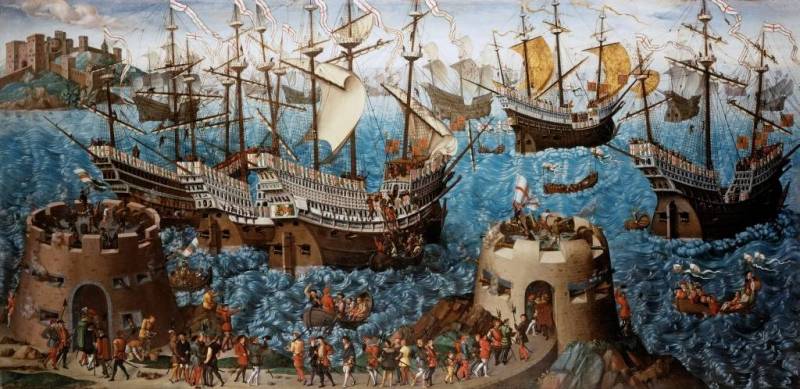
Departure of Henry VIII from Dover. Unknown artist. Written around 1520-1540. Hampton Court Palace Gallery, England.
This vivid painting depicts Henry VIII and his fleet sailing from Dover to Calais on May 31, 1520 to meet Francis I at the "Field of the Brocade of Gold". Henry VIII is depicted standing on one of the ships with golden sails in the background. The lack of artistic propriety in depicting the size of the ships may have been a deliberate device to convey the spectacular nature of this voyage and the overwhelming splendor of the English court. Dover Castle is shown in the upper left corner, with two round gun turrets in the foreground saluting the royal squadron. The painting is not recorded in the inventories of 1542 and 1547, perhaps because it was installed within the walls of Whitehall Palace. It was probably ordered by Henry VIII in memory of such an event as a meeting at the "Field of Golden Brocade"
and prepared warships.
First Book of Maccabees, 15:3
History in documents. And it so happened that after the publication of the material on VO “Medieval ships and medieval miniatures"A number of readers were asked to continue this topic and talk about the ships that replaced the medieval courts. But was there a source in that transitional era from the Middle Ages to the New Age that would allow us to approach it with the greatest possible accuracy and show not our afterthought about this subject, but directly what the contemporaries of these ships saw around them.
In the case of the first article, the sources of our information were medieval miniatures from manuscripts. But what source of the New Time could we use, both textual and illustrative? And here is the most important question: is there such a source, and if so, what is its content?
And now, as it turned out, we have just such a source on the ships of the beginning - the middle of the XNUMXth century. This is the so-called "Anthony's Scroll", and just today we will get to know him.
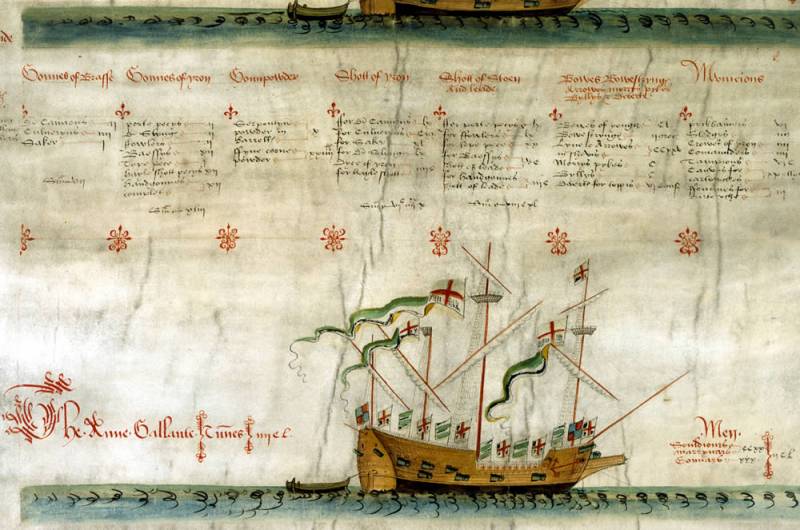
This is what a page from the second "Anthony Scroll" looks like. British Library, London
Rolls
"Anthony's Scroll" or "Anthony Roll" (this is how English sources call this document) is nothing more than a written account of the courts of English fleet King Henry VIII, which dates back to 1540. It is named so in honor of its author Anthony, and he wrote the text and drew all the drawings.
Initially, it included three rolls of parchment, with images of 58 warships. Their size, the number of crew members and the number of guns were also reported, and about each ship. According to Anthony, everything that happens on the ship was described there, along with "ammunition, artillery and everything that is needed for war."
The first scroll lists the carracks and begins with the largest ship in the English fleet, the Henry Grace e'Dew.
The second list contains galleys - hybrids of a rowing and sailing vessel, and one of the galleys also got there.
Finally, the third scroll describes the royal pinnases and "row barges," essentially smaller versions of the galleass.
All three scrolls were approximately the same length, about 4,6 m, and, most likely, in order to be examined, they were placed on a table or hung on a wall.
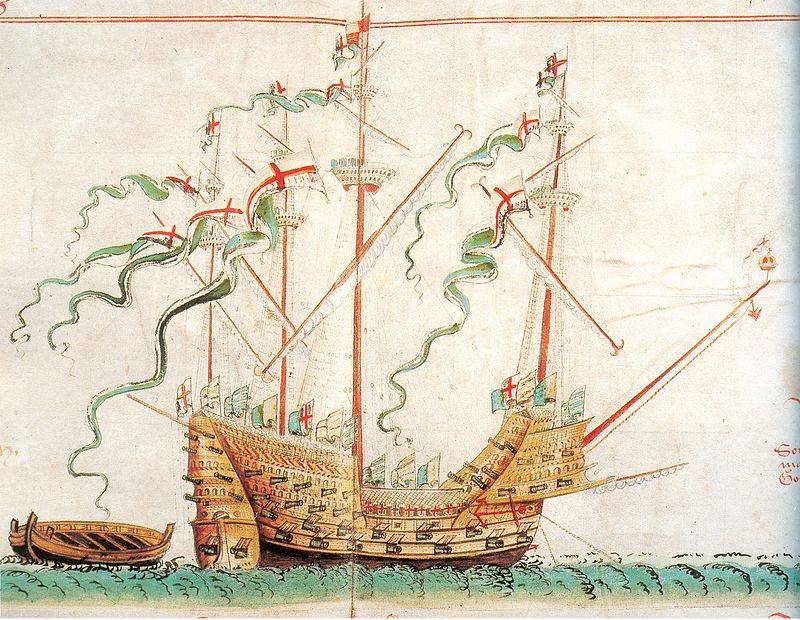
The flagship "Henry Grace e'Dew" or, as it was also called, "Great Harry". Attention is drawn to the characteristic architecture of this and other similar ships, namely, high superstructures at the bow and stern. It is interesting that all decks of the ship are covered with "roofs" made of mesh, woven from ropes and reinforced on the rafters. Such a net was stretched in order to protect the ship from boarding. Well, high superstructures were needed in order to be able to fire from top to bottom on the decks of a lower ship. Illustration from "Anthony Roll"
King Henry VIII received all three scrolls in 1546, after which they ended up in the royal library. But in 1680, King Charles II gave two scrolls to Samuel Pepys, who was supposedly working on the history of the British Navy, and he cut them up and then bound them into the form of a book, which is now kept in the Pepys library at Magdalen College, Cambridge.
As for the third scroll, it remained in the possession of the crown until it occurred to King William IV to give it to his daughter Lady Mary Fox, who sold it to the British Museum in 1858. This scroll is now in the British Library.
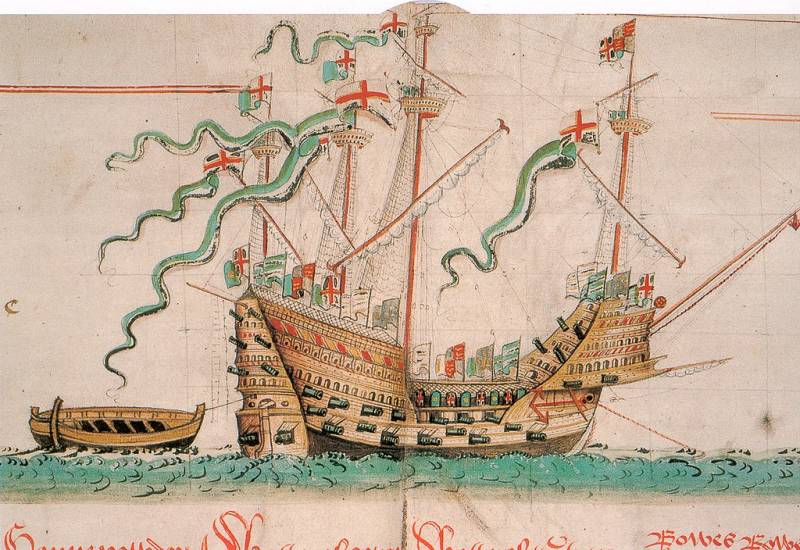
The Mary Rose is a ship very similar in architecture to the Great Harry. Pay attention to the guns that look back at the deck from the front turret. The calculation was that the enemy would try to board the lowest place on the ship, that is, the waist. And then it will be possible to bring down fire on it from two sides at once - from the forecastle (superstructure on the bow) and from the superstructure on the poop! Illustration from "Anthony Roll"
Ships
"Anthony Roll" - today is the only illustrated work known to us, which is a list of ships of the English fleet of the era of Henry VIII. As it turned out, the descriptions given in his text are very accurate. But most of the images of ships are very arbitrary and clearly made according to the standard of a rather primitive property. Therefore, the level of detail of the ship's design, and the location of weapons, and especially its rigging - all this turned out to be very, very approximate.
But despite this, it was thanks to the images in the "Scroll" that historians received interesting information regarding the study of heraldry, flags and ship decor of that time.
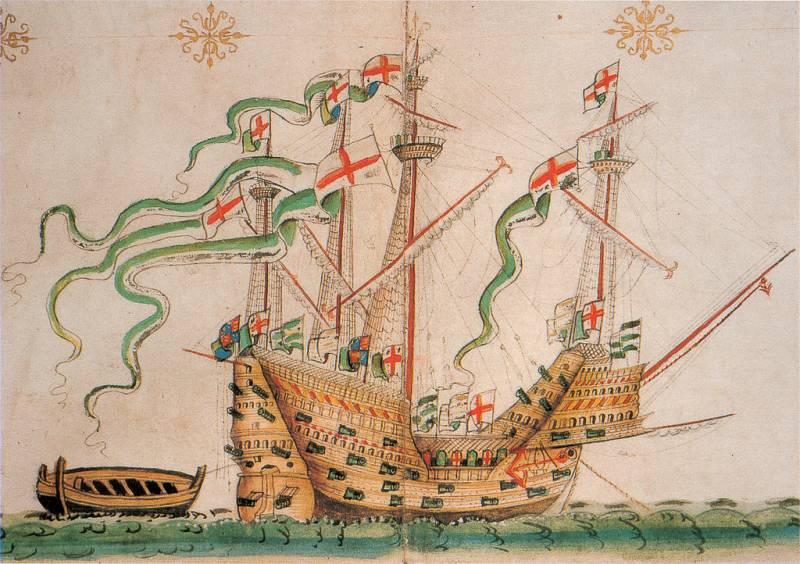
Sistership "Mary Rose" - carrack "Peter Garnet"
In addition, drawings of ships such as the Henry Grace e'Dew and the Mary Rose are no longer there, and we can only see them in the Anthony Roll. It is very important that the Mary Rose, after she sank in 1545, was successfully raised in 1982, so that it was possible to compare the information from the Scroll with the artifacts from the salvaged ship, and this comparison allowed us to take a fresh look at naval history of the Tudor era.

Another fighting carrack of the Tudor fleet with rows of cannon ports along the sides is the Fat Man ship. In fact, these were already the most real battleships. But the tactics of linear combat had not yet been developed, and the main stake in the battle was still made on boarding. This led to the fact that relatively few heavy guns were placed on the sides of the ships. But on the other hand, many small-caliber breech-loading guns were installed in superstructures. It was from there that the heaviest fire was fired on the decks of enemy ships. Illustration from "Anthony Roll"
As already noted, the author and illustrator of this document was Anthony Anthony (before 1530–1564), a government official whose name and signature are found in documents of that time. Anthony's father was William Anthony (died 1535), a Fleming from Middelburg in Zeeland who emigrated to England in 1503. William was engaged in supplying beer for the army, and Anthony also followed in the footsteps of his father - no later than 1530, he began supplying beer for the fleet.
But in 1533 Anthony was appointed artilleryman to the Tower of London, and this appointment was the first step towards his career as a civil servant, and nominally he was listed in this position until his death. At the same time, he rose to the rank of overseer of the Artillery Directorate, responsible for providing the army and navy with artillery and ammunition, and it was in this position that he made his list.
In 1549, he became a "master", that is, he received the position of chief of artillery weapons of the Tower, Calais, Boulogne and a number of other places, that is, he was appointed to a very responsible position at that time.
Examining the "Anthony Scroll" one can say that it clearly belongs to the number of documents that were made in order to fulfill a double task.
First, the Scroll could no doubt serve as a "reference book" for the king and the military leadership, since it listed all the ships of the royal fleet along with their weapons.
And secondly, he was clearly a boastful and lively display of Tudor military power. With the help of these three scrolls, one could subtly flatter the king, impress the courtiers with their diligence, and at the same time show foreign ambassadors the military power of England at sea.
Why did Anthony draw his ships?
Well, certainly not from nature, because ... then they would obviously look different. Obviously, he had some kind of source before his eyes. In addition to the painting "Landing at Dover", three more canvases are known that could serve as a source for Anthony's illustrations. These are “The Way of Anna of Cleves from the Netherlands to England” (1539), “The Attack of the French on the Coastal Fort” (the date of writing is unknown) and “The French Raid on Brighton” (July 1545). The images of the ships in these paintings are very close to what we see on the scrolls.
It is authentically known that all three scrolls were presented to the king in 1546. The inclusion in the first scroll of the Mary Rose, sunk at the Battle of the Solent on July 19, 1545, does not seem at all surprising, because even in 1549 it was still considered possible that she could be raised. The galleas, Antelope, Deer, Ox and Tiger, which are on the second list, also made the list, although in March 1546 they were still under construction, and the Deer did not go to sea until October of this the same year. But for some reason, the Blanchard galley, captured from the French on May 18, 1546, is not included in the lists.
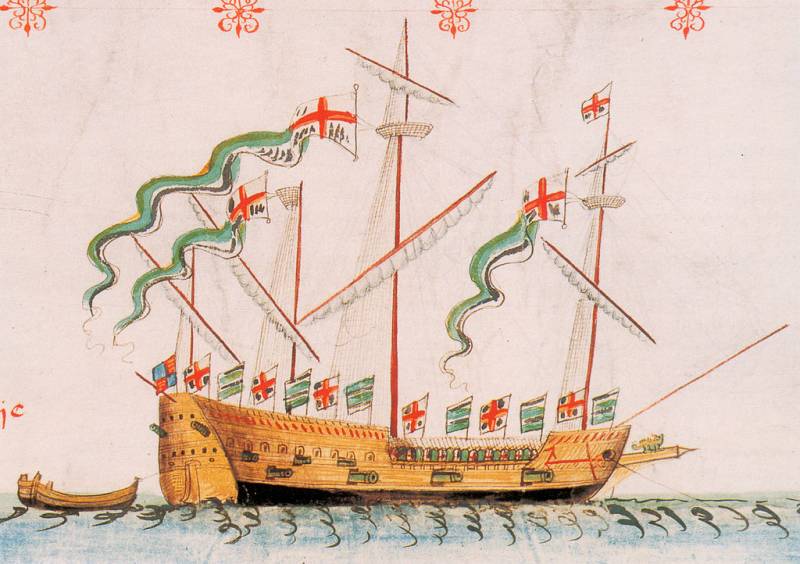
Pinasse "Salamander". Illustration from "Anthony Roll"
Style
Anthony's style may well be characterized as amateur, but it is clear that he tried to depict the ships as accurately as possible and show them in all their glory. And he gave free rein to his imagination. The ship tree is painted light brown, but the decorations and anchors are red, and for some reason green was chosen for the guns. The contours are black, and the colors of the sea vary in shades from "grayish green" to "rich blue".
So, from any point of view, as a historical document, "Anthony Roll" is simply unique. This is the only fully illustrated list of the Tudor Royal Navy that has come down to our time, even if its depictions are not scrupulously accurate. In any case, they were painted by a contemporary of that real life. Even if the number of guns on individual ships indicated in the text only approximately corresponds to their images in the illustrations. The rigging of the ships is also depicted rather conditionally, and many details of the ship's rigging are omitted from the drawings.
Comparison with the finds from the Mary Rose made it possible to verify the accuracy of the entries presented in the List. Anthony's depiction of the ship has given historians an idea of the ship's basic design features, such as the number of masts and sails. When compared with the ship inventory of 1514, there is a close match, proving that the illustration is largely accurate.
However, a study of the details of the construction shows that Anthony has a certain artistic liberties.
So, the armament on the painted ship looks clearly exaggerated. The number of gun ports on board is inaccurate as it implies two rows of nine ports slightly staggered, while the surviving starboard side of the Mary Rose has only one row of gun ports on the main deck with seven ports.
The accuracy of the tank was more difficult to ascertain as nothing was left of it. List of ammunition, small arms weapons, longbows, arrows, pikes and everything else exactly matches the archaeological evidence.
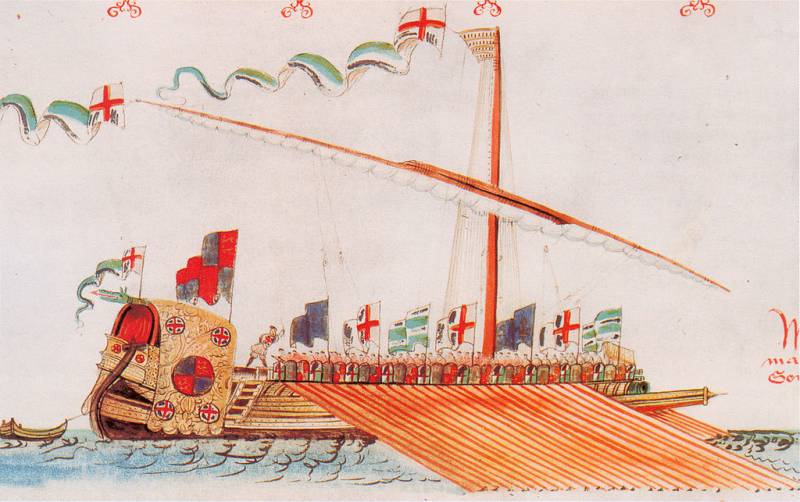
Mediterranean-type galley called "Thin". One of the most carefully and authentically executed drawings from the Anthony Scroll. It is believed that Henry VIII had a special attachment to the galleys, and perhaps that is why it is drawn so diligently ... Illustration from "Anthony Roll"
Flags
"Anthony Roll" provides us with detailed information about the flags used on ships.
According to vexillologist Timothy Wilson, the flags and pennants depicted in the Scrolls are "the most detailed source of information about the flags flown on the ships of King Henry VIII, and contain more visual detail than all other sources combined."
Among the most noticeable and striking are the elongated pennants fluttering on all ships, but in different numbers. They depict a red cross of St. George on a white background at the flagpole. And all these pennants are equipped with a very long tail with green and white stripes. All of them are painted with gold paint on a red and green background, and silver (which today has oxidized to black) on white. This artistic technique was most likely used to show the use of metal threads in those fabrics that were on pennants.
Along the sides of all ships, especially on the large carracks, we see rows of flags with heraldic images, including the English royal coat of arms, the fleur-de-lis of the French coat of arms, the crosses of St. George and the monogram of Henry VIII (HR). That is, thanks to the Scroll, we now know what the flags looked like on the ships of Tudor England, and what they usually depicted.
So, for all the conventionality of the images of the "Anthony Scroll", its value is difficult to overestimate, it is like a kind of look into the past, although not entirely and not in everything accurate.
Information